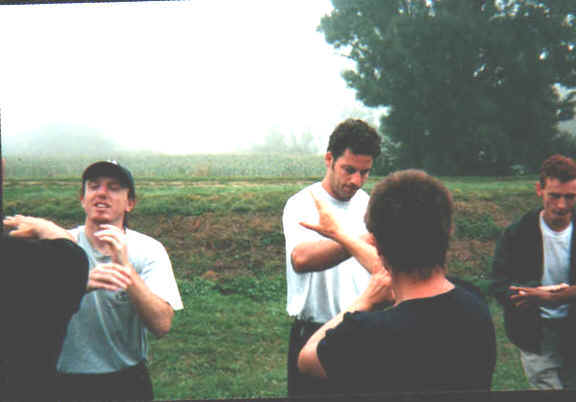|
To bring back an art to its
value.
Loriano Belluomini
Baguazhang (Pakua chang, Pa-kua Chang) is a martial art that was born
around the end of 1800 as synthesis of techniques of fighting (mostly Shaolin and Xingyi but also
Taiji) and of cultivation of the health (Taoist and Buddhist qigong). The origin still remains in a relative obscurity. In every case,
altough recalling its ancient philosophical and cosmogonic concepts as those of the
wuji, taiji, liangyi, sixiang and bagua, it rose as pure art of fighting as
it is seen by the fact that in it were quickly co-opted experienced
artists of Shaolin as Yin Fu and of Shuaijiao as Cheng Tinghua. Since this art mainly used the palms, to it the name was given
“zhang” (palms) and not quan (fists) showing therefore also in the name its innovative and particular aspect.
The representatives of the Baguazhang of that time were therefore fighters that found their employment as watches of the emperor,
soldiers and generals (as Fu Zhensong ) or escorts to the commercial caravans. How
did we come to the situation of today in wich the Baguazhang is quoted
more for the beauty of its movements that for its practicality and effectiveness?
Unfortunately it seems as native effectiveness began to fade away toward the third
or fourth generation. It almost entirely went lost after the 1949 revolutionary victory when the new government established an ideological climate that wanted to sweep away what was of old man and of feudal. I have practised with many teachers of bagua but I have to say that I have rarely found again the power of once, and where I have found again the power of once (for example with teachers as Fu Meilan and
Fu Wen Long (nephews of Fu Zhensong) or with Xie Peiqi and Liu Jingru of Beijing I have however found a certain technical insufficiency; and as
it could otherwise be? Baguazhang has lost, in the time, the stimulus to the adjustment to the times, to the adjustment of the techniques to the real practice: and, despite this, the continuous practice of the same forms, has created strong people (and I have known a lot of of
them indeed),
really disciplined, that would give thread to twist to many western apprentices. The fact stays that
we cannot currently teach Bagua in West as it is taught in China; it is
not even possible, on the other hand, if we don't want to denaturalize this art, to move entirely
to the modern sanshou (fighting) as it seems to do someone. It is necessary to find the correct alternative between tradition and renewal, to save the tradition recreating
it in a frame of more modern practice.
I can say these things-for which courage is needed - really because the last 14 years of my life have been devoted to it, to know and to practise
its various schools. I have entirely practised the school Cheng of Liu Jingru (Beijing) and the Fu Zhensong
school (Guangzhou); I almost entirely know the Yin Fu school of Zhu Baozhen (Beijing), my actual teacher, and I have practised the
Sun school, the Gao Yisheng school of Tianjin and Jiang Rongqiao's, always
in Tianjin; I know a variety of circular and linear forms, duilian (forms of pre-arranged
fighting), tuishou (pushing hands) and weapons.
I practice regularly Taijiquan (Fu and Sun schools, this last one in the mediation of Fu Zhensong) and Xingyiquan of Sun Lutang.
Moreover, as a lot of people in Kungfu, I was exposed to a variety of principles
and techniques
of different schools, for ex. those of the Yiquan. Said this, as my credentials, my problem has always been to bring
back the Bagua to its ancient efficiency.
I have never accepted what it is read here and there: that the bagua forms
are only a formality of movement but that the techniques are not effective. I know that the Bagua has historically been a fighting art and
in Lucca, where I teach, I think to have brought back this art to its native taste. After various years and attempts, the program of Bagua is finally structured with forms
(in Lucca I mainly teach the
Yin Fu and Fu Zhensong schools), weapons (solo and two man
forms), techniques solo and two-man, duilian or pre-arranged
fightings, tui-shou, tui-san (fighting beginning from the tuishou), bagua lianhuan (a form of
half-freefighting that teaches to move and to change) and, at the end of every lesson, free fighting. I have to say that, with my satisfaction, I have seen my best students fight indeed using the taste of the Bagua and the techniques of the Bagua. And this denies the whole defeatism that is
current today. The principal techniques we use are drawn out from the forms themselves and from the traditional
duilians as the “24 forms”, “Shiliuba” or “16 techniques” and the Longxing bagua Tuishou, “the pushing hands of the
Dragon-form”, created by Fu Zhensong. Furthermore there are barehanded and
kicking duilians.

Use of Xuezhang (sharp palm) at Jasnieres (France), July 2001.
In this same direction other people march, I am aware of it. The first one that
has perhaps put himself on on this road was Luigi Zanini . Another was Fabio Sandonà, my student and currently instructor of the school Cheng
in Padova. It could be said that Fabio is becoming the leader of this tradition. We sometimes
meet and we practice together. He almost entirely has finished the program. Another student that is a good instructor, for the
Fu school is Cristiano Tori of Lucca while for the school Yin, always to Lucca, Maurice Mazzei assists me.
The Baguazhang is so perhaps returning to its native value.
Go to the ENGLISH
HOMEPAGE
Go to the HOMEPAGE
|